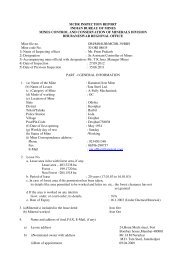Market Survey on Copper - Indian Bureau of Mines
Market Survey on Copper - Indian Bureau of Mines
Market Survey on Copper - Indian Bureau of Mines
You also want an ePaper? Increase the reach of your titles
YUMPU automatically turns print PDFs into web optimized ePapers that Google loves.
<strong>of</strong> frother molecule leads to its adsorpti<strong>on</strong> i.e. molecules c<strong>on</strong>centrate in the<br />
surface layer with n<strong>on</strong>-polar groups oriented towards the air and polar group<br />
towards the water. Frothing acti<strong>on</strong> is due to the ability <strong>of</strong> frother to adsorb <strong>on</strong><br />
the air-water interface, because <strong>of</strong> its surface activity and to reduce the surface<br />
tensi<strong>on</strong>, thus, stabilising the air bubble. Frother must be to some extent soluble<br />
in water. The acids, amines and alcohols are the most widely used frothers<br />
since they have practically no collecti<strong>on</strong> properties.<br />
Pine oil which c<strong>on</strong>tains aromatic alcohols has been widely used as<br />
frother in copper ore flotati<strong>on</strong> plants. Cresol (cresylic acid: CH3C6 H4OH) is<br />
also widely used.<br />
A wide range <strong>of</strong> synthetic frothers, based mainly <strong>on</strong> high molecular<br />
weight alcohols is now in use in many plants. A typical synthetic frother is<br />
Dowfroth-250, which is being widely used in copper flotati<strong>on</strong> plants.<br />
Combinati<strong>on</strong> <strong>of</strong> two or more frothers is also reported to give better<br />
performance.<br />
iii) Regulators: Regulators or modifiers are widely used in copper ore<br />
flotati<strong>on</strong> to modify the acti<strong>on</strong> <strong>of</strong> collector either by intensifying or reducing its<br />
water repellent effect <strong>on</strong> the mineral surface. They, thus, make collector acti<strong>on</strong><br />
more selective towards certain minerals. Regulators can be classified as<br />
activators, depressants, dispersants and pH modifiers.<br />
iv) Activators: These reagents modify the mineral surfaces so as to make<br />
them hydrophobic and susceptible to collector acti<strong>on</strong>. Activators are generally<br />
soluble salts which i<strong>on</strong>ize in soluti<strong>on</strong> and the i<strong>on</strong>s then react with the mineral<br />
surface. Activators are occasi<strong>on</strong>ally used in copper flotati<strong>on</strong>. Oxide minerals <strong>of</strong><br />
copper like azurite, malachite, etc. sluggishly float with collectors and need<br />
large dosages. Such minerals are activated by use <strong>of</strong> sodium sulphide or sodium<br />
hydrosulphide. The sodium sulphide should be added in stages and its amount<br />
should be carefully c<strong>on</strong>trolled, as excess amount depresses even activated oxide<br />
minerals and also the sulphide minerals.<br />
v) Depressants: Depressants are employed to ensure selective flotati<strong>on</strong> by<br />
rendering certain minerals hydrophilic (water avid), preventing their flotati<strong>on</strong>.<br />
There are many types <strong>of</strong> depressants and their acti<strong>on</strong>s are complex. Cyanides<br />
are widely used in copper-zinc and copper pyrite separati<strong>on</strong>. Sodium cyanide is<br />
more comm<strong>on</strong>ly used depressant.<br />
The depressing acti<strong>on</strong> <strong>of</strong> cyanide depends <strong>on</strong> its c<strong>on</strong>centrati<strong>on</strong>, pH value<br />
and length <strong>of</strong> xanthenes hydrocarb<strong>on</strong> chain. Depressing effect <strong>of</strong> cyanide i<strong>on</strong><br />
increases with pH. It is maximum (100%) at pH 13 and minimum (0.06%) at<br />
pH
















